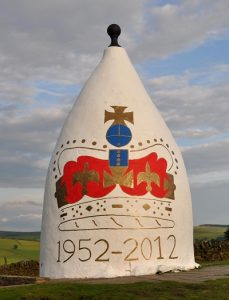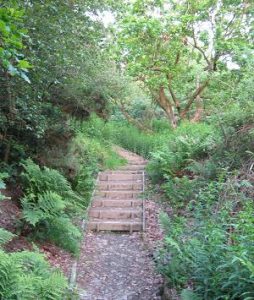Origin of the name | What & Why? | Steps | Woodland path | Spectacular Views | View from above! | Jubilee Nancy | Waterloo Nancy | KRIV | Conservation
How to get there
White Nancy is a very popular walking destination. Indeed, walking is the only way of getting there! Your walk can start from a number of different places, but many start from within Bollington or Kerridge. Everyone is very welcome BUT please park considerately! Bollington is very short of parking space and street parking is often not possible particularly at weekends. We don’t take kindly to those who park just anywhere. If you are visiting from outside the area be prepared to find a space some distance from the foot of the hill. However, there are two free (under review!) and untimed public carparks (as well as others further away) – Pool Bank is in the very centre of the old town beside Palmerston Street, opposite High Street. In Kerridge there is a small carpark off Jackson Lane, almost opposite the entrance to Hollin Hall Hotel. Walking to White Nancy from these carparks and other start points is described on a separate page.

This stunning photo of White Nancy and Kerridge Ridge, silhouetted against the setting sun, was taken by Lorraine Moss! A variety of pictures of White Nancy are available for use as computer screen wallpaper.
Nancy voted most loved local landmark! The borough council ran an internet Pride of Place vote to find out which was the most loved local landmark and, no surprise to Bollingtonians, our very own White Nancy won by a mile with almost 25% of the votes cast. Macclesfield Forest came second with Tatton Hall third.
What and why?
 |
White Nancy was actually built as a summer house by John Gaskell, who lived below the hill at Ingersley House, now Ingersley Hall, in about 1815. It is stone built with external rendering and regularly painted white in order to maintain its visibility. It is thought that it may have been built at that time to commemorate the battle of Waterloo. Internally there is a seat all round the wall with a large table in the centre. The circular table is cut from a single piece of stone. Before Nancy was built the site was occupied by a beacon described by Marriott in his work on the Antiquities of Lyme, 1810, as ‘… a small rotund of brick’. These beacons were erected on high points all over England in which fires could be lit to warn people of invasion. |
The stone ball on the top was carved in later years by Bollington stone mason Ted Allen, Linda Stewart’s grandfather.
The structure is believed to have been erected by a man named Dod who is supposed to have celebrated his work by enjoying a tot of brandy and then reciting a jingle …
Here’s to the mountain of Nancy
That’s built upon Ingersley Hill
Here’s good health, wealth and fancy
And give Dod another gill!
A gill (pronounced like Jill) is an Imperial measure of fluid once used to dispense alcoholic drink. Dod was an uncle of Joseph Wetton a local quarry owner.
Dod wasn’t the only poet to write about Nancy – James Shepley Chatterton wrote many poems including a delightful one about Nancy. He wrote this on 8th July 1919 – read it on his page.
Origin of the name …

As to the origin of the name ‘White Nancy’, there are several theories but none has any firm evidence to support it. It may have been named after a Gaskell daughter, Nancy (we have a record of one by that name, John Gaskell’s sister). Then again, maybe after the horse that is said to have hauled the heavy stone table top up the hill.
My preferred theory is that the name is derived from the fact that Kerridge hill has a stone trigonometric point – properly known as an Ordnance point – on its highest hill. These were established by the military in the 18th and 19th centuries to enable surveying for map making. Soon after its construction White Nancy was referred to as Northern Nancy, reflecting the fact that she was constructed at the north end of the hill upon which there was an Ordnance point. We know that the structure was painted white as early as 1856 (see this poem). Take your pick!
The Gaskell family are said to have left an endowment for the annual maintenance of our Nancy – the princely sum of 2/6 per annum; that’s 2 shillings and 6 pence or half a crown in old money and 12½p in decimal currency!
Edward ‘Ted’ Allen (b.1907 d.1958, Linda Stewart’s grandfather) was a stone mason. He owned one of the quarries on Windmill Lane. Although all the local history attributes the making of the the ball on top of White Nancy to one Tommy Cooper it was in fact Ted who made it. Tommy Cooper was council leader at the time, and told the council he could make it. When he tried to carve a new ball it cracked in half. Ted, who was a fine stone mason, made a replacement and Cooper took all the accolades!
* Peter Etherington is one of many prolific and skilful artists who live in and around Bollington. Their work is on public display each year at the Bollington Art Group![]() annual show in the early summer, held at the Civic Hall. Watch for announcements.
annual show in the early summer, held at the Civic Hall. Watch for announcements.
Waterloo celebration!!
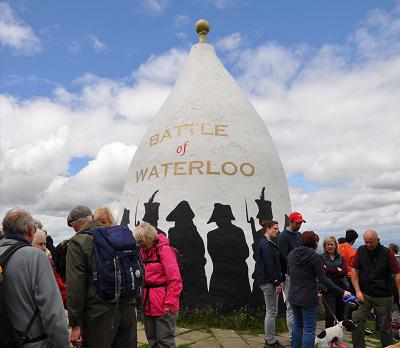 Over the weekend of 19th – 21st June 2015 Bollington enjoyed a programme of events to celebrate the 200th anniversary of the victory at the Battle of Waterloo as well as the 200th anniversary of the building of White Nancy on Kerridge hill which was itself erected to remember the victory at Waterloo.
Over the weekend of 19th – 21st June 2015 Bollington enjoyed a programme of events to celebrate the 200th anniversary of the victory at the Battle of Waterloo as well as the 200th anniversary of the building of White Nancy on Kerridge hill which was itself erected to remember the victory at Waterloo.
Events included a remembrance at the grave of James Robertshaw, the only Bollingtonian known to have fought at Waterloo, a Ceilidh, a Waterloo supper, welly planting, welly throwing, and to close the events a huge picnic attended by hundreds of townsfolk on Kerridge hill around White Nancy (picture right). The monument had been specially decorated for the event – a competition was held and the winning design can be seen in the picture.
Regular decoration
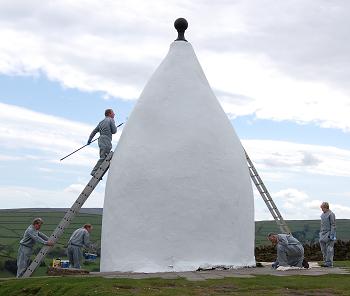 In the 1980s, at Christmas, Nancy was painted in artistic form such as a Father Christmas or Plum Pudding! In more recent years it has suffered at the hands of vandals with graffiti and on one occasion it was painted overall in pink! In May 2009 it was repainted in time for the Festival with a fresh coat of white and, for the first time in many years, with a black top. This colour certainly aids ones view of the whole monument on cloudy days.
In the 1980s, at Christmas, Nancy was painted in artistic form such as a Father Christmas or Plum Pudding! In more recent years it has suffered at the hands of vandals with graffiti and on one occasion it was painted overall in pink! In May 2009 it was repainted in time for the Festival with a fresh coat of white and, for the first time in many years, with a black top. This colour certainly aids ones view of the whole monument on cloudy days.
In 1919 James Shepley Chatterton wrote a delightful poem about White Nancy (click to read).
Gift to the town!
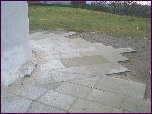 |
During 1999 Nancy was completely repaired, re-plastered and repainted by local contractor Allen Stringer. He also gave her a coat of anti-graffiti wax but unfortunately this was damaged by vandals who later painted the monument with house paint. Stone paving has been laid around the base of Nancy in the form of a compass. N, E, W and S have been inscribed in the appropriate points. |
Millennium project
The Kerridge Ridge and Ingersley Vale Countryside & Heritage Project was carried out over five years to 2010. The objective was to preserve and develop those aspects of the area that are most enjoyed by the local population. A major item was the construction of the new woodland path to the top of the hill, see next item …
The KRIV work party continue to meet each Friday to maintain the hill and the surrounding area in the condition it was raised to by the project.
Woodland path up Kerridge Hill!
 |
Interpretation boards are provided to give walkers information on the trees to be seen along the path. |
Kerridge Steps
 The path up the north face of Kerridge Hill has always been steep and was often difficult especially in wet or frozen weather. In order to improve accessibility the Town Council decided that a proper path should be constructed from the private roadway that crosses the north face of the hill (the middle road) to the top. This project became known as the Kerridge Steps.
The path up the north face of Kerridge Hill has always been steep and was often difficult especially in wet or frozen weather. In order to improve accessibility the Town Council decided that a proper path should be constructed from the private roadway that crosses the north face of the hill (the middle road) to the top. This project became known as the Kerridge Steps.
Experts were sought from Cumbria where they have considerable experience in building paths and steps on hillsides. The type of construction recommended was a pitched stone path. This is where blocks of stone are settled into the ground edge on. The idea is to reduce to a minimum the possibility of the stones tilting and becoming dislodged. With careful construction this technique provides a high level of grip to the feet with very little opportunity to slip and a progression of steps at alternate angles across the path so making it reasonably easy for walkers with different stride lengths to progress up or down the hill in a comfortable manner.
This path is used by more than 40,000 people each year. Many taking longer walks go only one way but others go up and down. Such traffic takes its toll on the paths and steps and after over fifteen years of this the stone path is showing distinct signs of wear. Several stones have moved, tilting over or moving away from their proper place. So care is needed, particularly when coming down – pay attention to the path, stop when taking in the fabulous view!
Some walkers have found the path difficult but it should be appreciated that the climb and descent is about 300 feet of continuous steps – human legs are not immediately capable of surmounting this many steps in one go! Especially coming down them! Take it carefully. You might find it easier to take the woodland path (described above) where the steps are wider spaced and interspersed with lengths of near level path.
What a fantastic view!
Kerridge Hill is renowned for its fabulous views. Whether it be the nearby hills to the east, the Cheshire plain to the west or Bollington laid out beneath you, there is so much to see from up here. We have two beautiful pictures taken by local photographer Roger Fielding. These panoramic views are in separate pages because they are on the large side, around 200k each.
- 300° view from White Nancy
 (wider angle)
(wider angle) - 150° view of the town from White Nancy
 (narrower angle)
(narrower angle) - 300° view from The Saddle
 (in the middle of Kerridge Hill, above Five Ashes)
(in the middle of Kerridge Hill, above Five Ashes)
Views of White Nancy are available on the Wallpaper page.
Conservation
White Nancy is within the Kerridge Conservation Area.
Listed buildings
The link is to the Images of England web site provided by Historic England.
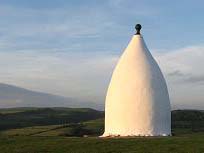 |
White Nancy monument |
 This c.18 foot high
This c.18 foot high 